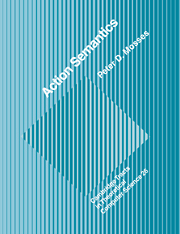Book contents
Chapter 2 - Action Semantic Descriptions
Published online by Cambridge University Press: 19 January 2010
Summary
Action semantic descriptions are divided into modules.
Grammars are used to specify abstract syntax.
Semantic equations are used to specify semantic functions.
Action semantics provides a standard notation for specifying semantic entities (actions, data, yielders).
The standard notation can be extended and specialized by means of algebraic specifications.
A semantic description consists of three main parts, concerned with specifying abstract syntax, semantic functions, and semantic entities. We specify these parts as separate modules, which, in larger specifications, may themselves be divided into submodules, just as we normally divide technical reports and textbooks into sections and subsections.
Let us adopt the following discipline in our modular specifications: each module has to have a title, and it has to be self-contained, in the sense that all the notation used in a module must be specified there too. Of course, when some module M uses notation that is already specified in another module M′, there is no point in repeating all of M′ literally in M: it is sufficient to refer to Mi from M, using its title. Similarly, when the submodules Mi of a module M use some common notation, we may as well specify that notation just once, at the level of M, letting it be inherited by each Mi. A reference to a module M thus provides not only the notation specified directly in M and its submodules, but also that which is specified in modules referenced by M and in supermodules enclosing M.
- Type
- Chapter
- Information
- Action Semantics , pp. 21 - 35Publisher: Cambridge University PressPrint publication year: 1992

